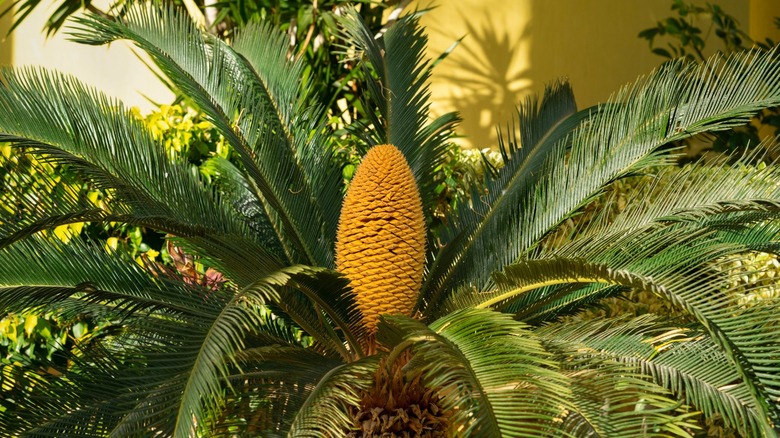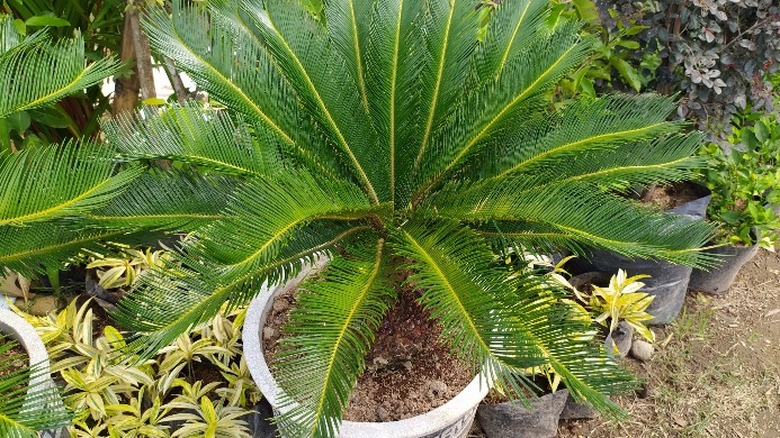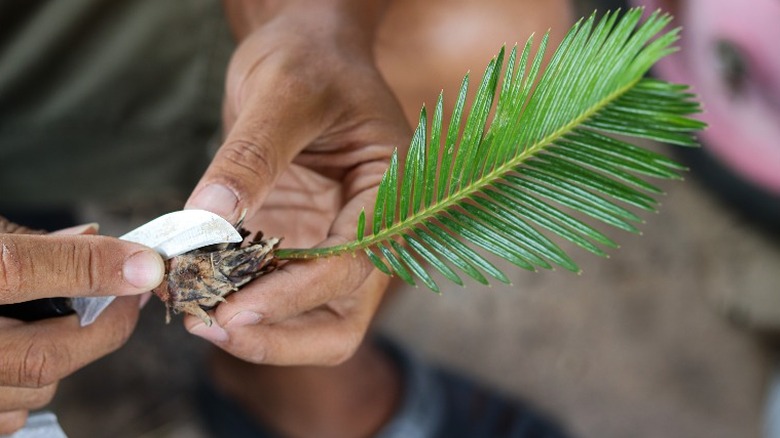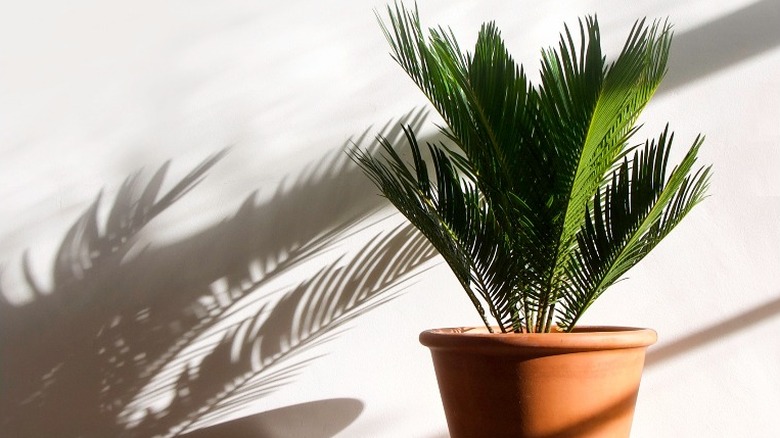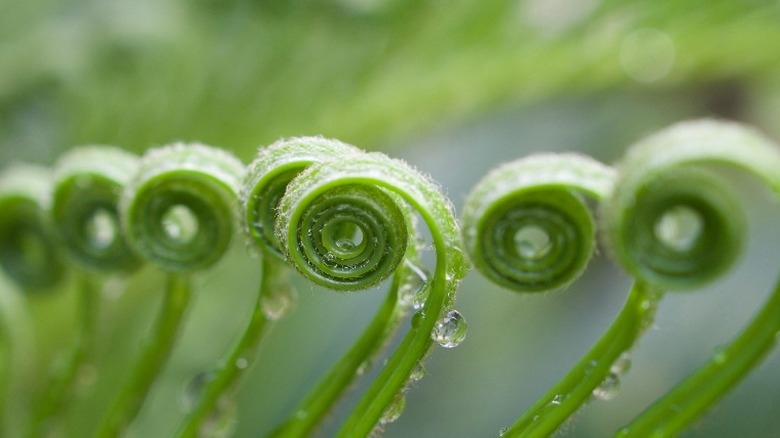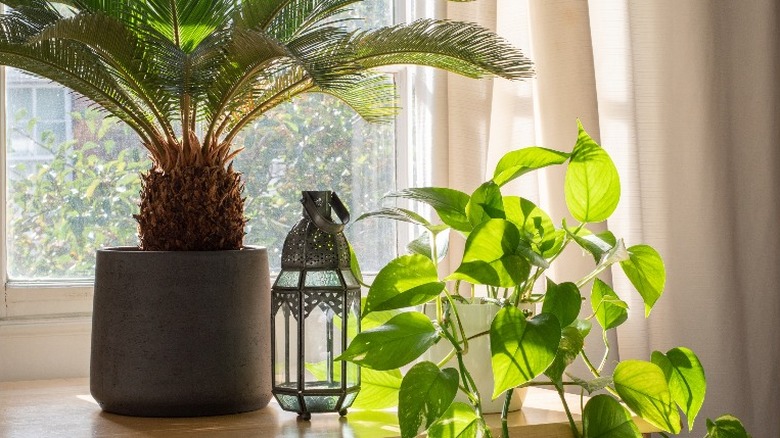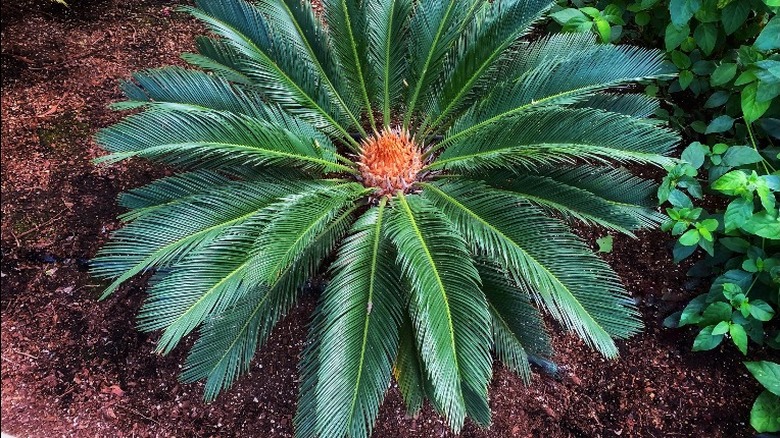What You Really Need To Know About Taking Care Of A Sago Palm Plant
The sago palm (Cycas revoluta) is a very popular plant for both indoor and outdoor gardeners. It's not a true palm tree, but a cycad, which is more closely related to the pine family. According to Cold Hardy Palms & Bamboo, it features large, green leaves that fan out from the branch, reminiscent of a pine tree.
As per the Houston Chronicle, there has been recent debate as to whether or not cycads deserve the title of living fossils, which is how the sago palm was previously referred to. Its ancestors certainly have been around for hundreds of millions of years, and it looks and even behaves like ancient plants with its large cone-shaped flowers and fern-like unfurling of the leaves, as noted by mygarden.com. Having survived in one form or another since the times of the dinosaurs, it's not surprising that Costa Farms listed the sago palm as one of the easiest houseplants to grow. Even if you're a truly terrible gardener, you probably won't be subjecting this plant to any catastrophic events!
How to use sago palm plants in garden
If you decide to grow your sago palm outside, you'll need to be aware of the two major headaches that this plant will throw up on a daily basis. As mentioned, those fascinating, prehistoric fronds that bring a symmetrical, classically tropical look to your garden are also sturdy needles that can get fairly prickly; hence, Gardener's Path advises keeping the leaves well away from high-traffic areas, especially where children or pets are likely to play.
The other issue is that every part of the sago palm, from leaf to root, is filled with poison, which Plant Care Today describes as a powerful neurotoxin that is poisonous to any living thing. While this is still an amazingly popular plant, if you've got animals or children that you fear might be tempted to nibble on a frond or a seed, it is advised to keep them and the sago palm far away from one other.
For these reasons, many cycad enthusiasts choose to grow sago palms in containers instead. The CSBE calls them an excellent container plant as they grow slowly and provide a tropical flair to wherever they're placed, typically on patios or in interior garden spaces.
How to grow sago palm plants
Sago palm trees are slow-growing plants that require a significant amount of time to reach maturity. In fact, the RHS estimates that it may take from 20 to 50 years for a sago palm to reach its final size.
Having said that, as long as you meet their favored conditions, sago palms will thrive with minimal intervention. The Spruce pointed out that while sago palms like full light and don't enjoy extended periods of drought, too much direct sunlight can burn the leaves and overwatering can be harmful. They also fare badly with temperatures below 23 degrees Fahrenheit. Therefore, growing a sago palm requires well-draining soil, lots of bright, indirect light, and protection from the cold when necessary.
To propagate the sago palm, the best option is to use the pups, or suckers, that mature plants produce around their base. Most gardeners remove these pups as part of the pruning process and many will happily give them away. Per HGTV, once the pup has been snipped from the mature tree, the roots and all but one or two leaves should be removed as well. Leave the pup to dry for a few days out of the sun before applying rooting hormone and planting it in a container of succulent potting mix. Keep the soil moist for a few weeks or months until new leaves and roots form, then replant in the springtime to avoid cold temperatures.
How to care for sago palm plants
Gardening Know How holds the opinion that the sago palm is a great plant for beginners because of how easy it is to take care of; however, it does have specific needs. For example, it requires well-draining soil and doesn't need watering too often. Too much water in and around the roots of a cycad (also known as wet feet) can very quickly lead to root rot and plant death. Therefore, it's better to err on the drier side rather than accidentally over-watering the tree.
Although too much direct sunlight can burn the leaves, especially in hot climates, sago palms do enjoy plenty of indirect sunlight, which will help to accelerate their tortoise-like growing speed. They also don't mind humidity, so a warm, well-lit spot in a conservatory, sunroom, or sunny windowsill would be ideal, suggests Better Homes & Gardens.
Fertilizing sago palm trees is necessary if you want to promote flowering, which takes place in late spring. However, only mature sago palms produce flowers, which means potentially waiting 15 years before seeing results.
Are sago palm plants toxic?
As previously stated, sago palm trees are extremely toxic. Though some cultures do use sago flour for food, the plant undergoes extensive processing to remove the toxins before it can be ingested. Dengarden notes that while all parts of the sago palm are toxic, the toxins are especially potent in the seeds.
Sago palm trees are not just toxic to humans; they are toxic to pets as well. As explained by Pet Poison Helpline, the active toxin in sago palm trees is cycasin, which can lead to liver failure in humans, dogs, and cats. Symptoms are usually visible from 15 minutes up to several hours after consumption. Central nervous system issues and severe liver failure can occur within two to three days. Unfortunately, the survival rate for animals is only around 50% even when medical treatment is immediately administered.
That being said, Dengarden states that many dogs have lived unharmed with multiple sago palms in the garden their entire lives. Perhaps because of the spiky nature of the plant, they have just learned to stay away from it. However, you should always take precautions to keep your pets safe.
How to repot sago palm plants
Because of the slow rate of growth associated with cycads, most gardeners, including the House Plants Expert, advise repotting only every three years or so.
Martha Stewart repotted some sago palms at her upstate New York farm in July 2020 and gave this step-by-step advice on how to go about moving sago palm trees from smaller to bigger containers. First, gently loosen the root ball from its container, so it can be removed easily, and check the soil and roots for any pests, damage, or rot. Untangle any roots that have become bound before making several cuts in the root ball to ensure new growth (without doing this, the roots will quickly return to their old, twisted-up shape). Next, place a bit of slightly sandy, well-draining soil in the base of the new pot, along with some good fertilizer. Put the sago palm in the center of the pot and fill in the space around it with more well-draining soil. Finally, moisten the soil and monitor closely until the repotted plant reestablishes itself.
How to use fertilizer with sago palm plants
Sago palm trees will generally grow well without fertilizer, but to truly thrive and produce flowers, they will need some fertilizing. Container-grown sago palms will also benefit from occasional feeding, depending on the type of fertilizer you use. According to the Home and Garden Information Center, cycads need to be fed regularly throughout the growing season. Compared to other plants, sago palms require more magnesium in their fertilizer as well as more micronutrients than most grasses or typical flowers.
The word that best describes sago palms is slow. That holds true for their fertilizers as well. As Plant Care Today noted, choosing a slow-release fertilizer is crucial when growing cycads, as well as one with a 12-4-12-4 ratio, which refers to the amount of nitrogen, phosphorous, potassium, and magnesium in the feed. A balance of micronutrients will also stave off any manganese deficiencies, which can cause the leaves of sago palms to turn yellow and wither. When using the recommended slow-release fertilizer, you will only need to administer it every three months to give your sago palm a boost.
